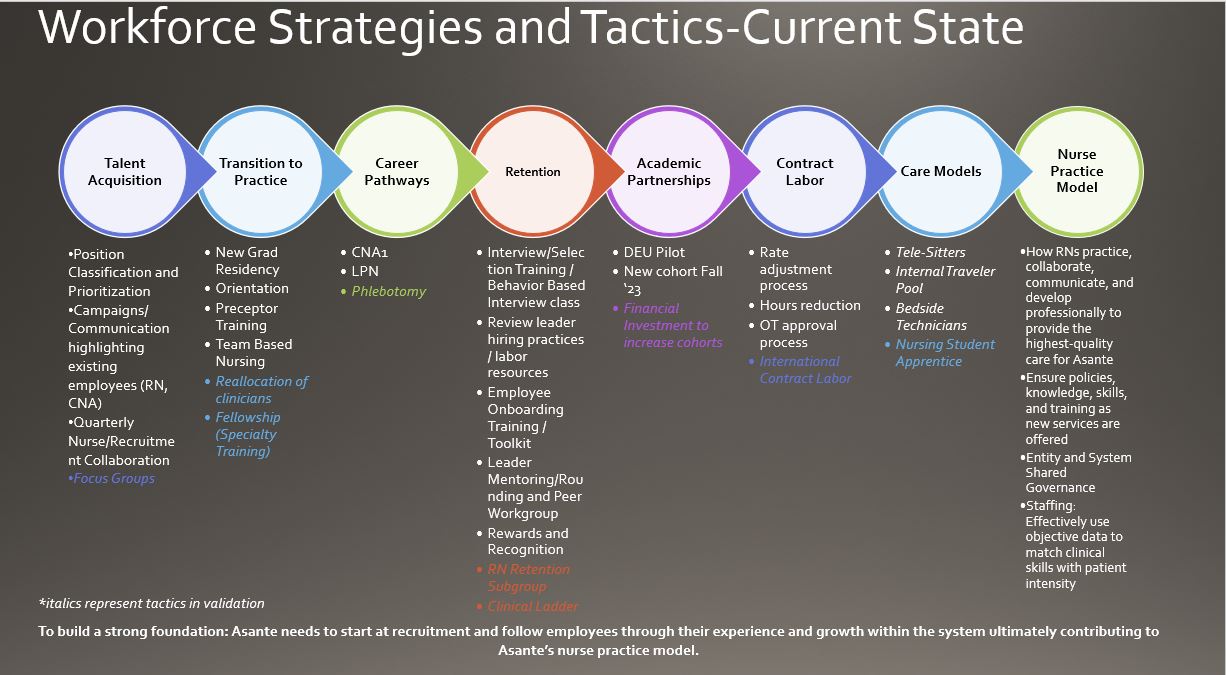Share:
After the surge: Seven ways we’re rebuilding our staff
It is well known that the pandemic worsened America’s already critical nursing shortage. We feel this acutely in our own hospitals. Just as the demand for nurses, CNAs and other clinical staff reached the highest levels in history, professional burnout, governmental vaccination mandates and the promise of more lucrative traveler positions caused longtime staff members to leave their jobs at an unprecedented rate.
As Asante emerges from the depths of COVID-19, we’re now surveying the landscape and planning our next steps. Chief among them are to fill 447 open nursing job openings and reduce our reliance on contract labor, which accounted for more than half of Asante’s nursing hours as recently as April.
In the longer term, returning to optimum staffing levels will require far more than increasing our recruiting efforts (although we’re doing that, too). It will take a holistic approach that could encompass everything from community partnerships to workplace culture.
As leaders, our first step is to recommit to the fundamentals that made Asante a respected health care system and a sought-after employer. These fundamentals include our dedication to patient-centered, high-quality care; solid financial stewardship; employee engagement; and staffing and capacity management.

The ways we’ll meet staffing demands are also varied. Here are eight key methods we’re focusing on now:
Talent acquisition
This involves allocating resources to the most critical areas of staffing needs and increasing sourcing for critical roles. Asante has developed a marketing campaign to attract new clinical staff; more tactics are outlined below.
Transition to practice
We’re helping the next generation enter the health care field and develop professionally through new-grad residencies, clinical orientation, preceptor training, team-based nursing and fellowship specialty training.
Career pathways
We know part of what retains staff are clear paths for professional development and career advancement. We are considering how to support CNAs, LPNs and phlebotomists to grow within the organization. A great example is recruitment of our CNA1s while supporting their advancement to CNA2 licensure.
Retention
As a recent article explained, Asante is offering leaders tools and resources to improve recruitment and retention. Efforts include improving the onboarding experience from job offer through first year and increasing rounding and ongoing support for employees.
Based on leader and staff feedback, Asante will be looking at ways to improve employee benefits and programs. Leaders will also continue to evaluate and monitor turnover to identify areas for improvement and to create a positive departmental culture. We’re also implementing a consistent feedback loop for staff to provide input and offer retention suggestions.
We are considering focused efforts on RN retention specifically with sub-groups, focus groups and our practice councils. We are also looking at wider spread implementation of clinical ladders across the organization. The clinical ladder is a structured system to provide nurses’ career advancement while remaining in their current clinical setting, providing direct patient care.
Academic partnerships
We recognize a critical pipeline is new graduate RNs. We are evaluating how to best partner with colleges and universities to engage future candidates earlier. Our hope is to positively contribute to the number of graduates who ultimately come to Asante for employment.
Contract labor
We’re taking a multipronged approach to reducing high-cost contract labor. This includes adjusting rates, hours and looking at more international travelers.
New care models
New ways of care delivery may help ease the staffing pressures. We’re evaluating options to support our staffing, which may include initiatives such as tele-sitters, an internal traveler pool, bedside technicians and nursing student apprentices to support some bedside functions.
Ultimately these efforts will shape our nurse practice model across Asante. This challenging time allows us to reexamine how RNs practice, collaborate, communicate and develop professionally to provide the highest-quality care for Asante.
We’re moving away from entity-based governance to a shared system that standardizes our practices across all three hospitals. For staffing, we will continue to use objective data to match clinical skills with patient intensity.
This long list of illustrates the challenges we have before us. As with any big effort, it will take everyone’s patience, dedication and enthusiasm to help us return to pre-pandemic levels (or better). When leaders round on your unit, please don’t hesitate to share your thoughts and ideas. Every voice counts.
If you have a question, please contact the author or relevant department directly.



